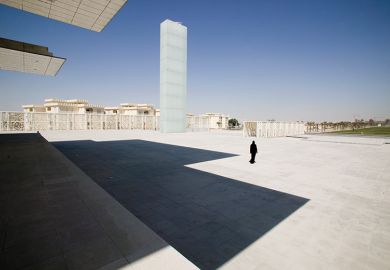A more organised research network in the Middle East, North Africa and Turkey (MENAT) could help to boost science in a region that is still suffering from “fragmented” local collaboration, a report suggests.
The rapid growth in research output in the region over the past few decades – which has risen from being 2 per cent of global publications to 8 per cent over the past 40 years – has been an “international success story”, says the analysis from Clarivate’s Institute for Scientific Information.
But much of this growing research capacity has been underpinned by collaborations between academics in the area and their peers in Europe, North America and, increasingly, China, rather than within the region.
Aside from co-authorships between Egypt and Saudi Arabia, which amounted to almost 16,000 papers indexed in the Web of Science between 2015 and 2019, ties between other MENAT nations were weaker than with countries outside the region, the data suggest.
For instance, Turkey shared about 2,800 papers with Saudi Arabia over the period, a smaller number than it shared with countries in the European Union, the US and China.
When only bilateral MENAT collaborations are included, excluding papers involving researchers from other countries, the ties seem even slimmer. For instance, Egypt shared just 90 such papers with Turkey between 2015 and 2019, whereas it shared 198 bilateral papers with Australia.
The report says regional collaboration has improved – it represented “barely” 1 per cent of the region’s output as recently as 2008 but has since climbed to 5 per cent – yet “the greater potential for regional networking remains to be realised”.
It could also be contrasted with the huge rise in collaboration with countries outside the region such as China, whose researchers co-authored fewer than 100 MENAT papers per year before 2000, a total that had climbed 6,800 papers in 2019.
The report asks whether some more formal organisation of regional science networks could boost research, noting that previous studies have found MENAT countries to favour collaboration with distant partners when allocating funding.
Pooling resources in the region could “more effectively meet the economic and societal challenges they face”, the report says.
“Collaboration within the region as well as with the rest of the world will also enhance the quality of scientific research, accelerate access to new markets and allow the financial costs of research to be shared.
“This could be mediated by a joint funding organisation, supported by all and linked to national budget capacity, led by outstanding scientists from across the region, staffed by an international secretariat and with transparent peer review of the highest international standards.”
Martin Szomszor, director of the Institute for Scientific Information, said the data “indicate that MENAT research shows high levels of global collaboration, resulting in diverse and high-quality output with rising impact”.
“However, regional collaboration remains relatively low and fragmented, and our analysis suggests that a collaborative regional network could improve competitiveness between the region and the rest of the world by focusing on shared needs and international priorities,” he said.
Register to continue
Why register?
- Registration is free and only takes a moment
- Once registered, you can read 3 articles a month
- Sign up for our newsletter
Subscribe
Or subscribe for unlimited access to:
- Unlimited access to news, views, insights & reviews
- Digital editions
- Digital access to THE’s university and college rankings analysis
Already registered or a current subscriber?








